How To Calculate Per Mile Cost
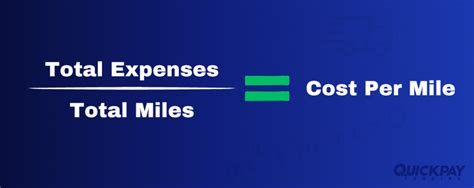
Calculating the per-mile cost of a vehicle is an essential practice for anyone looking to manage their transportation expenses effectively. This metric provides valuable insights into the true cost of ownership and operation, allowing drivers to make informed decisions about their vehicle choices and maintenance strategies. In this comprehensive guide, we will delve into the process of calculating per-mile costs, explore the factors that influence them, and offer practical tips for optimizing your vehicle's efficiency and long-term affordability.
Understanding Per-Mile Cost Calculation
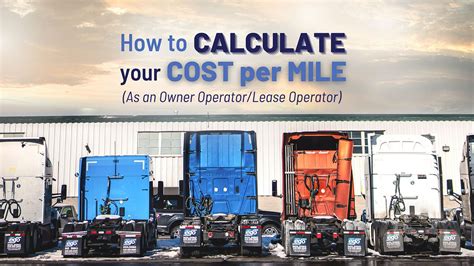
The per-mile cost of a vehicle is a financial metric that represents the total cost of operating and maintaining a vehicle for a specific distance. It considers various expenses, including fuel, maintenance, repairs, insurance, and depreciation, and divides them by the total number of miles driven. This calculation provides a clear picture of the cost per unit of distance traveled, allowing drivers to compare different vehicles and make cost-effective choices.
For instance, let's consider a hypothetical scenario involving two vehicles: Car A and Car B. Car A, a compact sedan, has an average fuel efficiency of 30 miles per gallon (MPG) and annual maintenance costs of $500. Car B, a larger SUV, achieves only 20 MPG but has lower annual maintenance expenses of $300. To calculate their per-mile costs, we'll consider a typical annual mileage of 15,000 miles.
| Vehicle | Fuel Efficiency (MPG) | Annual Maintenance Cost | Annual Mileage | Per-Mile Cost |
|---|---|---|---|---|
| Car A | 30 MPG | $500 | 15,000 miles | $0.073/mile |
| Car B | 20 MPG | $300 | 15,000 miles | $0.08/mile |
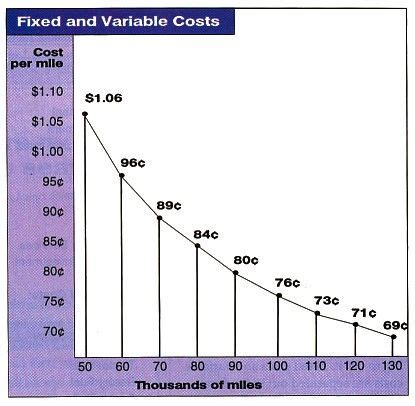
As we can see, despite Car B's lower maintenance costs, its inferior fuel efficiency results in a higher per-mile cost. This calculation highlights the importance of considering various factors when assessing the true cost of vehicle ownership.
Factors Influencing Per-Mile Cost
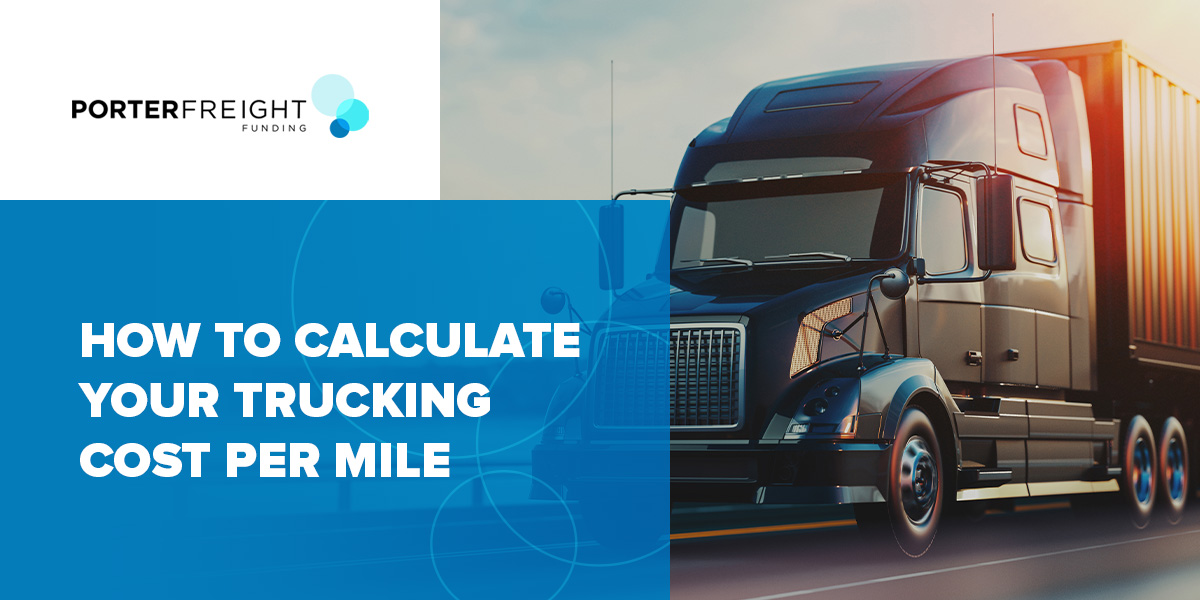
Several key factors contribute to the overall per-mile cost of a vehicle. Understanding these elements is crucial for accurate cost estimation and strategic vehicle management.
Fuel Efficiency
Fuel efficiency, measured in miles per gallon (MPG) or liters per 100 kilometers (L/100 km), is a significant determinant of per-mile costs. Vehicles with higher MPG ratings consume less fuel, resulting in lower fuel expenses over time. This factor is particularly influential for drivers who cover extensive distances regularly.
For example, let's compare two vehicles with different fuel efficiency ratings. Vehicle X, a hybrid sedan, achieves an impressive 50 MPG, while Vehicle Y, a traditional gasoline-powered SUV, manages only 25 MPG. Over a year of driving 15,000 miles, the difference in fuel costs can be substantial.
| Vehicle | Fuel Efficiency (MPG) | Annual Mileage | Fuel Cost per Gallon | Annual Fuel Cost |
|---|---|---|---|---|
| Vehicle X | 50 MPG | 15,000 miles | $3/gallon | $900 |
| Vehicle Y | 25 MPG | 15,000 miles | $3/gallon | $1,800 |
In this scenario, Vehicle X's superior fuel efficiency leads to significantly lower annual fuel costs, making it a more cost-effective choice for drivers with high mileage needs.
Maintenance and Repair Costs
The frequency and cost of maintenance and repairs are vital considerations when calculating per-mile expenses. Some vehicles may require more frequent service or have higher repair costs, impacting their overall affordability. Regular maintenance, such as oil changes, tire rotations, and filter replacements, are essential for keeping vehicles in optimal condition and preventing costly breakdowns.
Imagine a scenario where two similar vehicles, Vehicle A and Vehicle B, have distinct maintenance requirements. Vehicle A, with its advanced technology and sophisticated engine, demands more frequent and specialized service, resulting in higher annual maintenance costs. In contrast, Vehicle B, a simpler model, requires fewer service visits and incurs lower maintenance expenses.
| Vehicle | Annual Maintenance Cost |
|---|---|
| Vehicle A | $1,200 |
| Vehicle B | $600 |
Over time, the cumulative maintenance costs can significantly influence the overall per-mile expense, making Vehicle B a more economical choice despite potential differences in other factors.
Insurance Premiums
Insurance premiums are another critical component of per-mile costs. The cost of insuring a vehicle can vary based on factors such as the driver’s age, driving history, location, and the vehicle’s make and model. Higher-value vehicles or those with more advanced features may attract higher insurance premiums, impacting the overall cost of ownership.
For instance, let's compare the insurance premiums for two vehicles: a standard sedan and a luxury sports car. Due to its higher value and performance capabilities, the sports car attracts significantly higher insurance premiums, adding to its overall per-mile expense.
| Vehicle | Annual Insurance Premium |
|---|---|
| Standard Sedan | $600 |
| Luxury Sports Car | $1,800 |
The difference in insurance premiums underscores the importance of considering insurance costs when assessing the true per-mile cost of a vehicle.
Depreciation
Depreciation, the decrease in a vehicle’s value over time, is an essential factor in per-mile cost calculations. Vehicles typically lose value as they age and accrue mileage, and this loss of value can significantly impact the overall cost of ownership. While depreciation is often an inevitable process, understanding its pace and magnitude can help drivers make informed decisions about vehicle choices and resale potential.
Let's illustrate this with an example. Vehicle X, a compact sedan, experiences a steady depreciation rate of 15% per year. On the other hand, Vehicle Y, a luxury SUV, depreciates at a faster rate of 20% annually. Over a period of five years, the cumulative depreciation can vary significantly between these two vehicles.
| Vehicle | Initial Value | Depreciation Rate | Cumulative Depreciation after 5 years |
|---|---|---|---|
| Vehicle X | $20,000 | 15% | $11,875 |
| Vehicle Y | $50,000 | 20% | $22,500 |
As we can see, Vehicle Y's higher depreciation rate leads to a more substantial loss in value over time, which can impact its overall per-mile cost calculation.
Calculating Per-Mile Cost: A Step-by-Step Guide
Now that we’ve explored the key factors influencing per-mile costs, let’s delve into the step-by-step process of calculating this crucial metric.
Step 1: Gather Relevant Data
To begin, collect all the necessary information about your vehicle and its expenses. This includes:
- Fuel Efficiency: Determine your vehicle’s average MPG or L/100 km rating.
- Maintenance Costs: Note the annual maintenance expenses, including regular service, repairs, and any unexpected breakdowns.
- Insurance Premiums: Obtain the annual insurance premium for your vehicle.
- Depreciation: Calculate the estimated annual depreciation rate for your vehicle based on its age and market value.
- Annual Mileage: Estimate the average annual mileage you expect to drive.
Step 2: Calculate Annual Costs
Once you have the necessary data, compute the annual costs associated with your vehicle:
- Fuel Cost: Multiply your vehicle’s MPG by the annual mileage and the cost per gallon of fuel. This gives you the annual fuel cost.
- Maintenance Cost: Sum up all the maintenance expenses for the year.
- Insurance Premium: Note the annual insurance premium.
- Depreciation Cost: Multiply the vehicle’s initial value by the annual depreciation rate to calculate the annual depreciation cost.
Step 3: Compute Per-Mile Cost
To determine the per-mile cost, divide the total annual costs by the annual mileage:
Per-Mile Cost = (Total Annual Costs) / Annual Mileage
This calculation provides a clear understanding of the cost per mile driven.
Optimizing Per-Mile Costs: Strategies and Tips
Now that you understand how to calculate per-mile costs, let’s explore some strategies and tips to optimize your vehicle’s efficiency and minimize overall expenses.
Fuel Efficiency Strategies
- Choose Efficient Vehicles: When selecting a new vehicle, prioritize fuel efficiency. Research and compare different models’ MPG ratings to find the most economical option for your needs.
- Drive Sensibly: Adopting eco-friendly driving habits, such as smooth acceleration and maintaining a steady speed, can significantly improve fuel efficiency and reduce fuel costs.
- Optimize Aerodynamics: Reduce drag by removing unnecessary roof racks or cargo carriers when not in use. Aerodynamic improvements can enhance fuel efficiency, especially at higher speeds.
- Use Cruise Control: On long highway trips, utilizing cruise control can maintain a steady speed, reducing fuel consumption and improving efficiency.
Maintenance and Repair Strategies
- Regular Maintenance: Stick to a rigorous maintenance schedule to keep your vehicle in optimal condition. Regular oil changes, tire rotations, and filter replacements can prevent costly breakdowns and extend the vehicle’s lifespan.
- DIY Repairs: For minor repairs and maintenance tasks, consider doing them yourself. This can save money and provide a deeper understanding of your vehicle’s maintenance needs.
- Shop Around for Repairs: When facing significant repairs, get quotes from multiple mechanics or repair shops to ensure you’re getting the best value for your money.
Insurance and Depreciation Management
- Shop for Insurance: Compare insurance policies and providers to find the best coverage at the most competitive rates. Ensure you understand the factors influencing your premiums and explore options to lower them, such as increasing your deductible.
- Manage Depreciation: To mitigate depreciation, consider purchasing a used vehicle in good condition. Used vehicles often have lower depreciation rates, making them a more cost-effective choice over time.
Future Implications and Trends
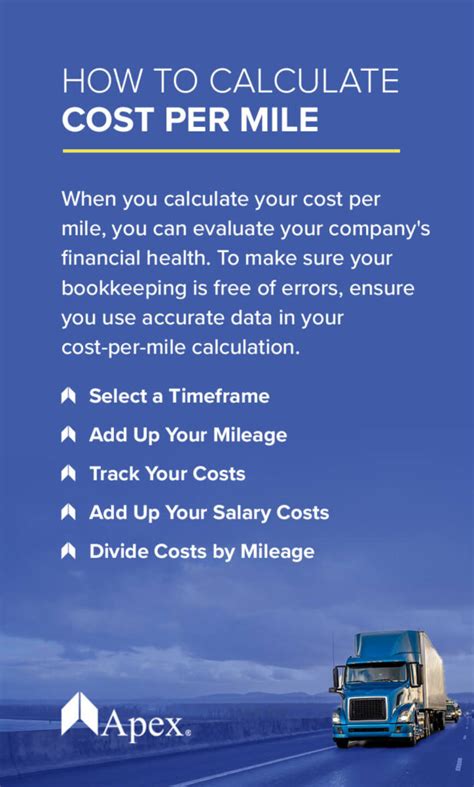
As technology advances and environmental concerns take center stage, the future of vehicle ownership and operation is poised for significant changes. Here’s a glimpse into the potential implications and trends that may shape the per-mile cost landscape:
Electric Vehicles (EVs)
The rise of electric vehicles is a game-changer in the automotive industry. EVs offer several advantages, including lower fuel costs, reduced maintenance expenses due to fewer moving parts, and potential tax incentives. However, initial purchase costs and the availability of charging infrastructure are critical factors to consider.
Autonomous Vehicles
Autonomous or self-driving vehicles are expected to revolutionize transportation. While still in development, these vehicles could potentially reduce accidents, improve traffic flow, and optimize routes, leading to lower fuel and maintenance costs. However, the initial cost of autonomous technology and regulatory hurdles may impact their widespread adoption.
Shared Mobility and Ride-Sharing
The shared mobility market, including ride-sharing and car-sharing services, is growing rapidly. These services offer convenient and cost-effective transportation options, especially for urban dwellers. As more people opt for shared mobility, the demand for personal vehicle ownership may decline, leading to potential savings in per-mile costs.
Alternative Fuels and Technologies
The automotive industry is exploring various alternative fuels and technologies to reduce emissions and improve efficiency. Hydrogen fuel cells, biofuels, and advanced hybrid systems are among the innovations being developed. While these technologies may impact per-mile costs, their widespread adoption and infrastructure development are crucial factors to consider.
Conclusion
Calculating per-mile costs is a powerful tool for managing transportation expenses and making informed decisions about vehicle ownership. By understanding the factors that influence per-mile expenses and adopting strategic approaches to fuel efficiency, maintenance, insurance, and depreciation, drivers can optimize their vehicles’ long-term affordability and overall cost-effectiveness.
As the automotive landscape evolves with technological advancements and sustainability initiatives, staying informed about emerging trends and innovations will be crucial for adapting to changing transportation dynamics. Whether through the adoption of electric vehicles, autonomous technology, or shared mobility services, the future of per-mile cost management promises exciting opportunities for efficient and sustainable transportation.
How often should I calculate my per-mile cost?
+It’s beneficial to calculate your per-mile cost annually to assess the changes in expenses and make informed decisions. However, more frequent calculations, such as every six months or even quarterly, can provide a more detailed understanding of your vehicle’s costs and help you identify areas for improvement.
Are there any online tools to help with per-mile cost calculations?
+Yes, there are several online calculators and apps available that can assist with per-mile cost calculations. These tools often consider factors like fuel efficiency, maintenance, and insurance to provide an estimate of your vehicle’s per-mile expense. Using these resources can simplify the calculation process and offer a quick snapshot of your costs.
Can I reduce my per-mile cost by driving less frequently?
+Reducing your mileage can indeed lower your per-mile cost. However, it’s essential to consider the fixed costs associated with vehicle ownership, such as insurance and depreciation. While driving less can decrease fuel and maintenance expenses, it may not significantly impact the overall per-mile cost if these fixed costs remain unchanged.


